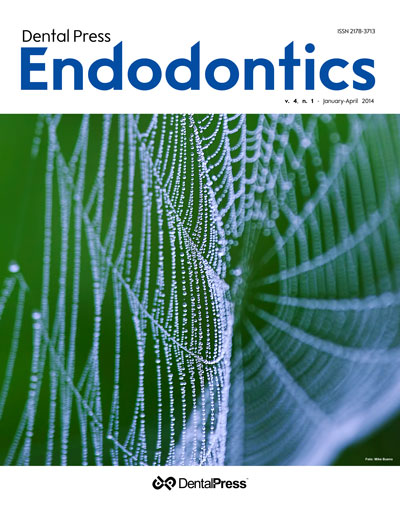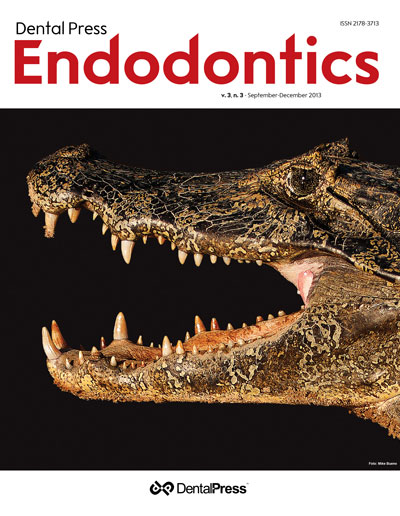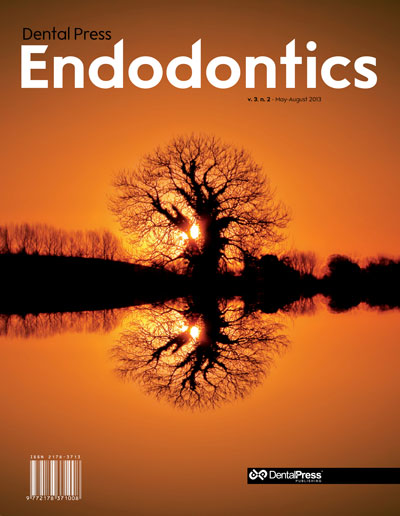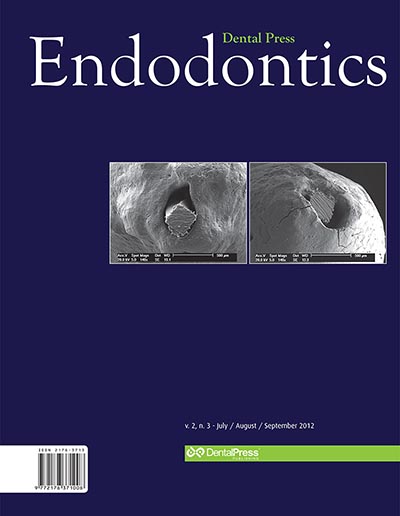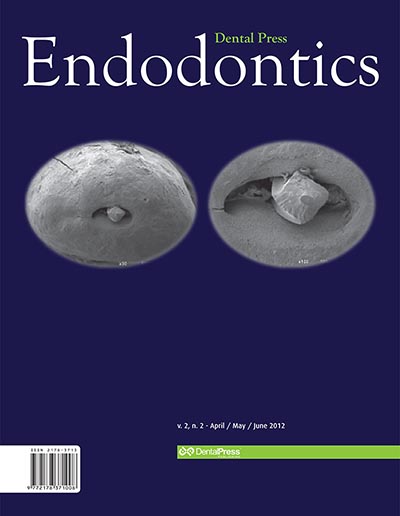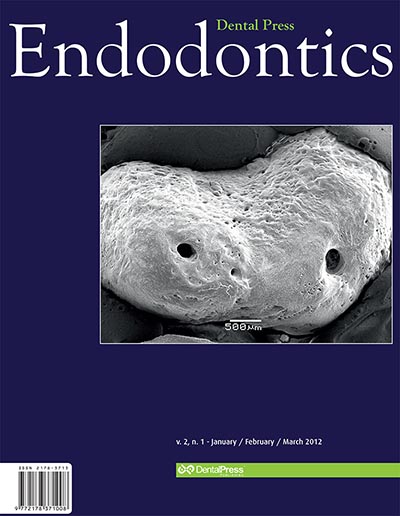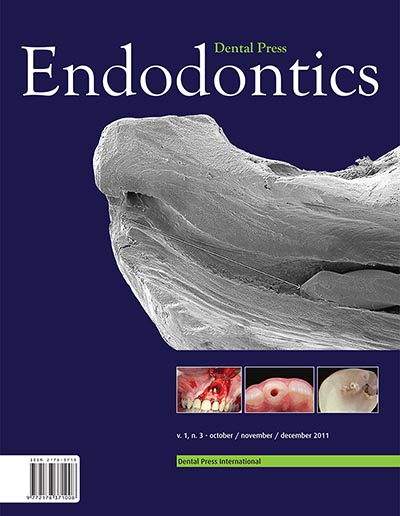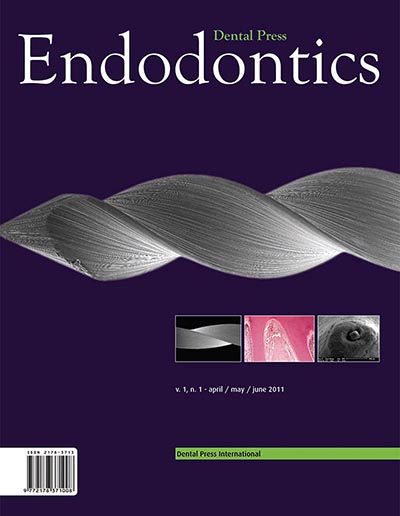v. 03, no. 3
Dental Press Endodontics – ISSN 2178-3713
Dental Press Endod.
v. 03, no. 3
September / December
2013
Editorial
The value of Endodontic Sciences experts
009 009
Endo in Endo
The presence of pus indicates bacteria at the site!
Abscess. Bacteria. Pus. Contamination.
010 015
The presence of pus necessarily suggests bacterial contamination caused by staphylococcus and streptococcus. Interaction of neutrophils with these bacteria represents the mechanism of formation of pus in the human body. The presence of these bacteria can be analyzed and questioned as follows: 1. Were the bacteria already present prior to the surgical procedure? 2. Was the material previously contaminated by bacteria? 3. Was there any failure in the aseptic procedure? 4. Was there lack of oral hygiene in the postoperative phase? If the pus is formed, staphylococcus and streptococcus are present.
Original articles
Comparison of the flexibility and torsional resistance of nickel-titanium rotary instruments
Mechanical torsion. Nickel. Dental instruments. Titanium.
016 022
Introduction: This study compared the flexibility and torsional resistance of two types of instruments manufactured with special NiTi alloys, and one with conventional NiTi.
Methods: Twisted File (TF) instruments manufactured with the R-phase of NiTi (SybronEndo, Orange, CA), and ProFile Vortex instruments (Dentsply Tulsa Dental, Tulsa, OK, USA) made of M-Wire NiTi were compared with RaCe (FKG Dentaire, La Chaux-de-Fonds, Switzerland) instruments made of conventional NiTi. Flexibility and torsion assays were carried out using twenty 25/0.06 instruments from each manufacturer. Statistical analysis was performed by ANOVA.
Results: The mechanical resistance of the instruments tested was significantly different. TF were the most flexible instruments, followed by RaCe and ProFile Vortex (P < 0.01). In the torsion assay, ProFile Vortex instruments endured the greatest maximum load and maximum torque values prior to fracture, followed by RaCe and TF (P < 0.01). The torsional resistance values of RaCe and TF were not significantly different (P = 0.061).
Conclusion: We observed a relationship between flexibility and torsional resistance (maximum torque and maximum angular deflection in torsion). The most flexible instrument (TF) was the least resistant to torsion, while the least flexible (ProFile Vortex) was the most resistant to torsion. RaCe presented intermediate results for both flexibility and torsional resistance.
Root apical third and canal morphology of teeth with hypercementosis
Hypercementosis. Dental pulp cavity. Endodontics.
023 031
Objective: This study aims at studying the influence of hypercementosis over root and root canal morphology using different methods of observation (clearing technique, radiography, stereomicroscopy and optical microscopy).
Methods: 130 teeth were selected for morphological comparative evaluation; all teeth were previously radiographed and stereomicroscopically evaluated. Out of these, 60 teeth with hypercementosis and 30 without it were selected for clearing technique evaluation. The analysis was based on aspects such as: type of hypercementosis; root canal number and configuration; root surface and presence of apical foramen and apical deltas. The remaining 20 teeth with hypercementosis were microscopically compared to 20 teeth with normal root formation by means of the Hematoxylin and Eosin (H.E.) staining technique, so as to study the cementum deposition pattern and morphological aspects of the root canal. The evaluation was performed by two examiners and submitted to Kappa agreement test. The data obtained was compared through non-parametric Kruskal-Wallis one-way analysis of variance test, and the Dunn test was applied for individual comparisons.
Results: The root clearing examination showed higher frequency of club shaped hypercementosis (65%) followed by focal hypercementosis (35%). Teeth with hypercementosis showed significant increase in the presence of apical deltas (53.3%). A higher frequency of root canal constrictions (55%), and changes in the original root canal path (46.6%) were also observed. Microscopic evaluation supports the influence of hypercementosis over the morphological characteristics of root apical third formation.
Conclusions:These findings show the existence of a complex root canal anatomy at the apical third of teeth with hypercementosis, which may hinder root canal treatment.
Comparison of changes in the pH of calcium hydroxide pastes associated with different vehicles
Calcium hydroxide. Intracanal dressing. Endodontics.
032 035
Introduction: The antimicrobial effect of calcium hydroxide has been assigned to its capacity to produce an alkaline shift in pH. This property is affected when calcium hydroxide is combined with other substances, such as 2% chlorhexidine gel and zinc oxide, which makes the action of the paste last longer.
Objective: This study assessed whether calcium hydroxide paste associated with chlorhexidine gel and zinc oxide promote pH shifts at short time intervals.
Methods: Calcium hydroxide pastes prepared with three vehicles: saline solution (paste A); propylene glycol (paste B); and 2% zinc oxide chlorhexidine gel (paste C) were placed into vials containing 15 ml of deionized water. A pH meter was used to detect pH shifts of combinations in different vehicles at seven time intervals: 15 and 30 minutes; 1, 24 and 48 hours; as well as 7 and 14 days.
Results: All three pastes presented a sharp increase of pH values at the first time interval and remained relatively stable at a value of about 12 from 24 hours to 7 days. After this period, the pH of pastes A and B decreased to 9.50, whereas that of paste C remained at 12.
Conclusions: Pastes A and B produced a faster alkaline shift of the solution, whereas paste C kept an elevated pH for a longer time, however, differences were not statistically significant.
Chlorhexidine and its applications in Endodontics: A literature review
Chlorhexidine. Microorganism control agent. Endodontics.
036 054
This study aims at presenting the properties of chlorhexidine used as an auxiliary chemical substance for endodontic instrumentation: structure and mechanism of action, substantivity, tissue solvent effect, chlorhexidine x sodium hypochlorite interaction, cytotoxicity, action over biofilm, antibacterial activity, antifungal activity, intracanal dressing, rheological action and allergic reactions. In Dentistry, chlorhexidine has been proved effective and safe against bacterial plaque since 1959. In Endodontics, it has been recommended in liquid or gel form, at different concentrations (usually 2%), as root canal irrigant and dressing (alone or associated with other substances). Additionally, it may be applied as an antimicrobial agent at all stages of root canal preparation, including disinfection of the operative field, removal of necrotic tissues before determining the root length, chemical-mechanical preparation before foraminal clearance and enlargement, disinfection of obturation cones; to shape the main cone with gutta-percha, to remove gutta-percha during retreatment, to disinfect the prosthetic space; etc. It is reasonable to conclude that chlorhexidine, at different concentrations, has an antimicrobial activity against Gram-positive as well as gram-negative bacteria and fungus. Its antimicrobial activity, increased by the substantivity effect, does not have the ability of solving tissues, which is overcome by the rheological action of its gel form that lubricates the endodontic instrumentation used. Its biocompatibility is acceptable with relative absence of cytotoxicity.
Pulp revascularization: a literature review
Pulp revascularization. Apexification. Blood coagulum
055 061
Permanent teeth with incomplete root formation are one of the greatest challenges of endodontic practice. These teeth need a type of treatment that is different from conventional endodontic therapy. The most common causes of incomplete root formation are: dental trauma and deep tooth cavity, both of which may lead to pulp necrosis. Teeth with incomplete root formation and pulp necrosis were usually treated by apexification. In other words, treatment comprised multiple sessions to replace calcium hydroxide-based root canal dressing and the fabrication of a MTA apical plug to create an apical barrier. Nevertheless, with this method, root dentin walls are thin and fragile. Thus, revascularization becomes a new treatment option that aims at promoting the completion of root formation, with invagination of a new connective tissue in the inner space of the pulp cavity. This study conducts a literature review comparing some case reports that focus on pulp revascularization in immature permanent teeth with pulp necrosis. Based on this review, it is reasonable to conclude that pulp revascularization is a feasible method for root maturation with thickening and, as a consequence, strengthening of young permanent teeth root walls.
Planning and diagnosis predictability by means of cone beam CT before endodontic treatment: clinical resolution
Cone beam computed tomography. Imaging diagnostic. Combined therapy.
062 068
Introduction: Diagnosis and planning of new interventions are crucial when implementing a treatment. One method routinely used to assist diagnosis is the periapical radiograph, however, with this technique, anatomical structures are compressed into two-dimensional images.
Objective: The aim of this study was to show the importance of CBCT in endodontic diagnosis before endodontic retreatment of buccal perforation of which clinical resolution was planned, guided and executed after image visualization with cone beam computed tomography (CBCT). After diagnosis, immediate clinical therapy comprising retreatment via canal, sealing the perforation with MTA, root rehabilitation with fiberglass post and crown shielding with composite resin was carried out in a single session.
Apical root resorption of vital and endodontically treated teeth after orthodontic treatment: A radiographic evaluation
Root resorption. Orthodontic treatment. Endodontics. Apical root resorption.
069 073
Introduction: Root resorption, generally expressed in a round apical shape, is one of the most common findings in the orthodontic clinic.
Objective: To radiographically evaluate whether vital and endodontically treated teeth present similar severity of apical root resorption in response to orthodontic treatment.
Methods: This study was conducted with twenty-eight patients who had one upper central incisor endodontically treated (experimental group) and its vital counterpart untreated (control group) before orthodontic movement. Measurements were made by means of periapical radiographs taken before and after orthodontic treatment.
Results: There were no statistically significant differences (P > 0.05) in apical root resorption levels between endodontically treated and vital teeth.
Conclusion: Endodontic treatment does not interfere in apical root resorption after orthodontic treatment.
Mandibular first premolar with three canals and two roots: A case report
Root canal therapy. Root canal preparation. Premolar.
074 077
Introduction: The possibility of additional root canals should be considered even in teeth with a low frequency of abnormal root canal anatomy, therefore demanding more attention of the clinician during root canal treatment.
Objective: This article reports a relatively uncommon clinical case of a mandibular first premolar with two roots and three canals which was successfully treated with root canal therapy.
Methods: After initial radiograph, the presence of two roots was detected. Additional care was taken to explore the root canals, confirming the presence of three canals with the aid of a microscope. The root canals were instrumented using a hybrid rotary technique advocated by the School of Dentistry from Piracicaba, and obturated using Sealer 26 and cold lateral compaction.
Conclusion:b> In order to achieve the best possible outcome in root canal treatment it is important to have a good knowledge of the root canal system morphology in addition to appropriately using the diagnostic tools.


